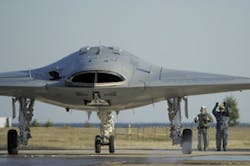X-47B drone demonstrates wireless ground handling for use on aircraft carriers
In early November, a team of Northrop Grumman (NYSE:NOC) engineers and U.S. Navy personnel completed its first shore-based trials of a control display unit (CDU), a wireless, handheld device. Developed by Northrop Grumman, the device enables deck operators to maneuver the X-47B by remote control on the carrier deck.
The team demonstrated the CDU's ability to control the X-47B's engine thrust; to roll the aircraft forward, brake and stop; to use its nose wheel steering to execute precise turns; and to maneuver the aircraft into a catapult or out of the landing area following a mock carrier landing.
In practice, a deck operator will work in tandem with the flight deck director to move the X-47B from the CDU to a designated flight deck location. Standing in front of the aircraft, the director will use traditional hand signals to indicate how, when and where the aircraft should move, as if they were communicating with a pilot in a manned aircraft. The deck operator will stand behind the director and use the CDU to duplicate the director's instructions as wireless commands to the aircraft.
The UCAS-D program plans to conduct its first shore-based catapults of X-47B aircraft later this month. That testing will be followed by hoisting an X-47B aboard an aircraft carrier, and using it to validate the performance of the CDU in an actual carrier environment.
In 2013, the program hopes to demonstrate the ability of an X-47B to safely operate from a Navy aircraft carrier, including launch, recovery, and air traffic control operations. The program also plans to mature technologies required for future Navy unmanned air vehicle (UAV) programs.
Northrop Grumman is the Navy's prime contractor for the UCAS Carrier Demonstration (UCAS-D) program. The UCAS-D industry team includes GKN Aerospace, Lockheed Martin, Pratt & Whitney, Eaton, General Electric, UTC Aerospace Systems, Dell, Honeywell, Moog, Wind River, Parker Aerospace and Rockwell Collins.
